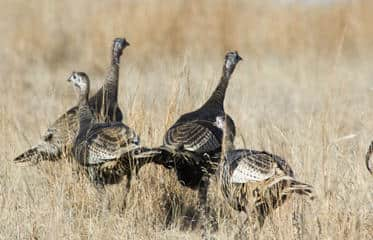Fall Turkey Season Opens October 1 in Kansas

The fall turkey season doesn’t have the tradition or build-up that surrounds the spring turkey season but only because it’s overshadowed by deer, waterfowl and upland bird hunting seasons. Kansas fall turkey hunters enjoy unsurpassed opportunities, in terms of season length, generous bag limits and odds of success.
The fall turkey season opens Oct. 1 and runs through Jan. 31, 2013, closing during firearm deer seasons. Hunters may hunt with shotguns, 20 gauge or larger using shot size No. 2 or smaller, and archery equipment. There are six Turkey Management Units established for the 2012-2013 season. In the past, the state was divided into four units; however biologists felt that new unit boundaries would allow more precise turkey population management and enhanced hunting opportunities. Unit 4 (southwest) is closed to fall turkey hunting. Hunters may obtain one turkey permit, valid in Units 1, 2, 3, 5 and 6, and hunters who possess a turkey permit may also purchase up to three turkey game tags, which are valid in Units 2, 3, 5 and 6. The turkey permit and turkey game tags each allow the harvest of one hen or tom turkey. Consult the 2012 Kansas Hunting and Furharvesting Regulations Summary for more information, as well as a map showing the new Turkey Management Units.
Last fall, just more than 8,000 hunters pursued turkeys in Kansas, and more than 30 percent of them took at least one turkey. All units provide excellent hunting opportunities, and the good news is that after several years of poor production and declining numbers, the population in southeast Kansas is rebounding. Many public lands managed by the Kansas Department of Wildlife, Parks and Tourism, as well as Walk-In Hunting Access lands hold turkeys, so hunters have a variety of choices.
Hunters also have several choices when it comes to the way they hunt fall turkeys. In the spring, only tom turkeys are legal, and most birds are taken when they respond to hunters’ calls imitating a hen. In the fall, there is no breeding activity, so hunters usually stalk birds or set up a point of ambush and hunt from a blind. However, calling can be effective in the fall. A popular hunting technique in regions with more fall turkey hunting tradition is to use a dog to scatter turkey flocks. Once dispersed, the hunter and dog hide quietly for a time. There is safety in numbers for turkeys, and the urge to re-flock is strong. Birds will use a “kee-kee-run” call to regroup, and the hiding hunter can imitate this call to bring a bird within shotgun or bow range. Dogs are not allowed during the spring season.
Whatever the technique, fall turkey hunting can be a break from the more traditional fall pursuits, as well as an exciting adventure. And those who’ve tried it will testify that roasted wild turkey is a welcome addition to the Thanksgiving table.

